Critique Review: Organizational Behavior and Motivation Techniques
VerifiedAdded on 2020/03/23
|8
|2135
|91
Report
AI Summary
This report provides a comprehensive critique of organizational behavior, examining its core concepts and the impact of various factors on employee performance and organizational success. It delves into the complexities of organizational behavior, encompassing workforce diversity, communication, and organizational culture. The report emphasizes the importance of motivation techniques, exploring their effects on employee productivity and the application of Maslow's hierarchy of needs. It also highlights the significance of leadership, ethical considerations, and the relationship between profitability and productivity. The analysis includes a discussion of key skills for managers, such as cooperative working styles, trustworthiness, and the ability to understand quality systems. The report further examines different motivation techniques and their effectiveness, considering factors like salary, bonuses, and a healthy work environment. The conclusion emphasizes the importance of motivation in increasing employee output and achieving organizational goals, with a focus on the need for well-qualified managers and the potential drawbacks of certain strategies.
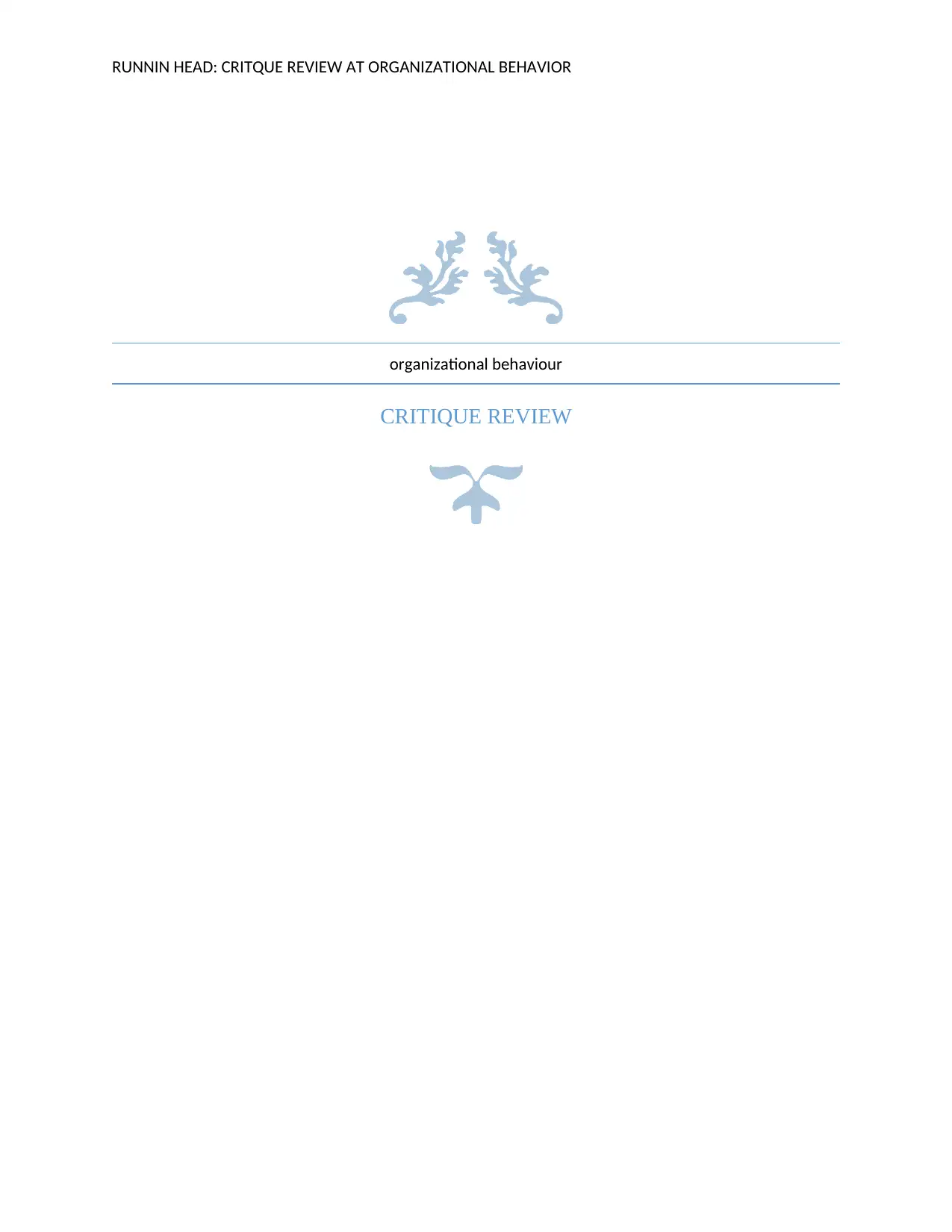
RUNNIN HEAD: CRITQUE REVIEW AT ORGANIZATIONAL BEHAVIOR
organizational behaviour
CRITIQUE REVIEW
organizational behaviour
CRITIQUE REVIEW
Paraphrase This Document
Need a fresh take? Get an instant paraphrase of this document with our AI Paraphraser
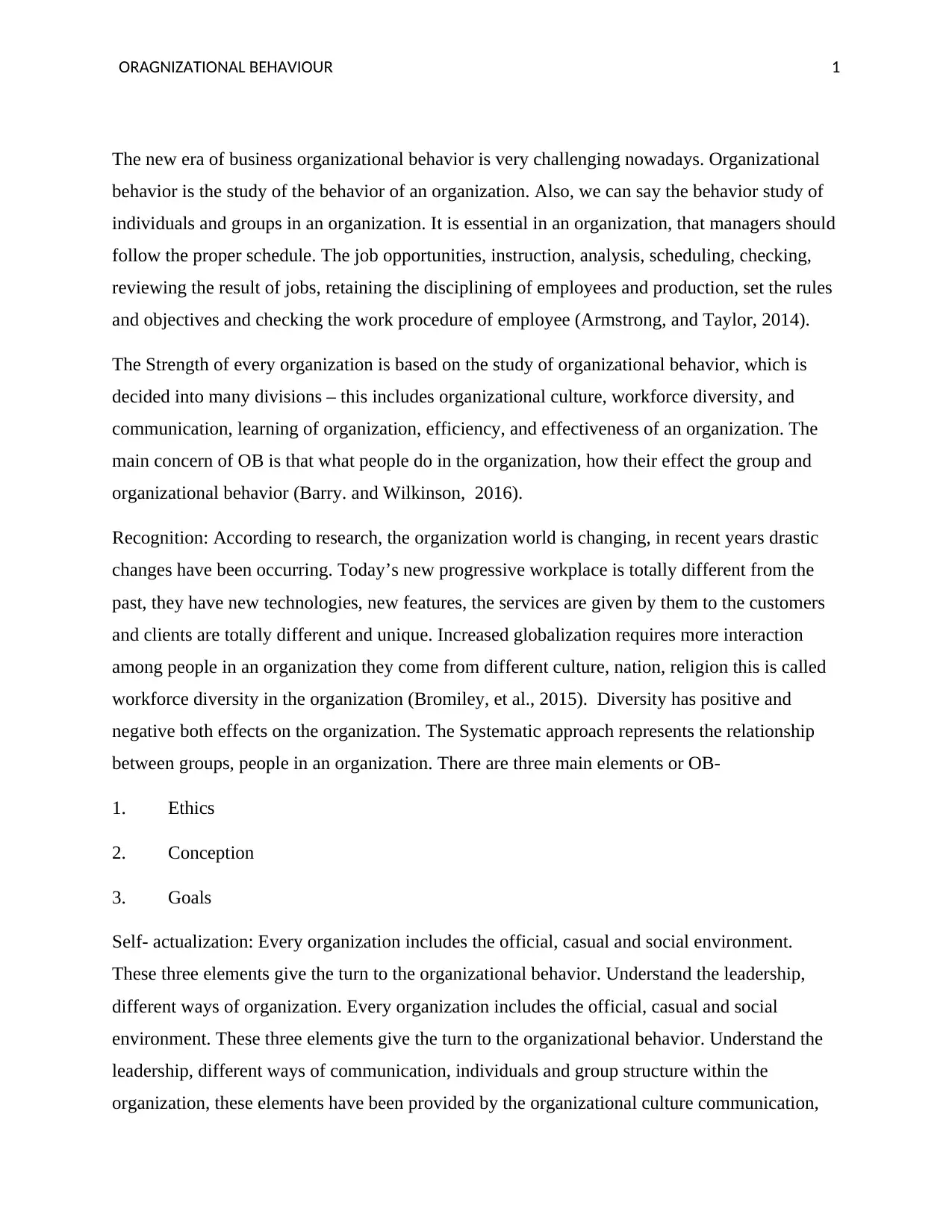
ORAGNIZATIONAL BEHAVIOUR 1
The new era of business organizational behavior is very challenging nowadays. Organizational
behavior is the study of the behavior of an organization. Also, we can say the behavior study of
individuals and groups in an organization. It is essential in an organization, that managers should
follow the proper schedule. The job opportunities, instruction, analysis, scheduling, checking,
reviewing the result of jobs, retaining the disciplining of employees and production, set the rules
and objectives and checking the work procedure of employee (Armstrong, and Taylor, 2014).
The Strength of every organization is based on the study of organizational behavior, which is
decided into many divisions – this includes organizational culture, workforce diversity, and
communication, learning of organization, efficiency, and effectiveness of an organization. The
main concern of OB is that what people do in the organization, how their effect the group and
organizational behavior (Barry. and Wilkinson, 2016).
Recognition: According to research, the organization world is changing, in recent years drastic
changes have been occurring. Today’s new progressive workplace is totally different from the
past, they have new technologies, new features, the services are given by them to the customers
and clients are totally different and unique. Increased globalization requires more interaction
among people in an organization they come from different culture, nation, religion this is called
workforce diversity in the organization (Bromiley, et al., 2015). Diversity has positive and
negative both effects on the organization. The Systematic approach represents the relationship
between groups, people in an organization. There are three main elements or OB-
1. Ethics
2. Conception
3. Goals
Self- actualization: Every organization includes the official, casual and social environment.
These three elements give the turn to the organizational behavior. Understand the leadership,
different ways of organization. Every organization includes the official, casual and social
environment. These three elements give the turn to the organizational behavior. Understand the
leadership, different ways of communication, individuals and group structure within the
organization, these elements have been provided by the organizational culture communication,
The new era of business organizational behavior is very challenging nowadays. Organizational
behavior is the study of the behavior of an organization. Also, we can say the behavior study of
individuals and groups in an organization. It is essential in an organization, that managers should
follow the proper schedule. The job opportunities, instruction, analysis, scheduling, checking,
reviewing the result of jobs, retaining the disciplining of employees and production, set the rules
and objectives and checking the work procedure of employee (Armstrong, and Taylor, 2014).
The Strength of every organization is based on the study of organizational behavior, which is
decided into many divisions – this includes organizational culture, workforce diversity, and
communication, learning of organization, efficiency, and effectiveness of an organization. The
main concern of OB is that what people do in the organization, how their effect the group and
organizational behavior (Barry. and Wilkinson, 2016).
Recognition: According to research, the organization world is changing, in recent years drastic
changes have been occurring. Today’s new progressive workplace is totally different from the
past, they have new technologies, new features, the services are given by them to the customers
and clients are totally different and unique. Increased globalization requires more interaction
among people in an organization they come from different culture, nation, religion this is called
workforce diversity in the organization (Bromiley, et al., 2015). Diversity has positive and
negative both effects on the organization. The Systematic approach represents the relationship
between groups, people in an organization. There are three main elements or OB-
1. Ethics
2. Conception
3. Goals
Self- actualization: Every organization includes the official, casual and social environment.
These three elements give the turn to the organizational behavior. Understand the leadership,
different ways of organization. Every organization includes the official, casual and social
environment. These three elements give the turn to the organizational behavior. Understand the
leadership, different ways of communication, individuals and group structure within the
organization, these elements have been provided by the organizational culture communication,
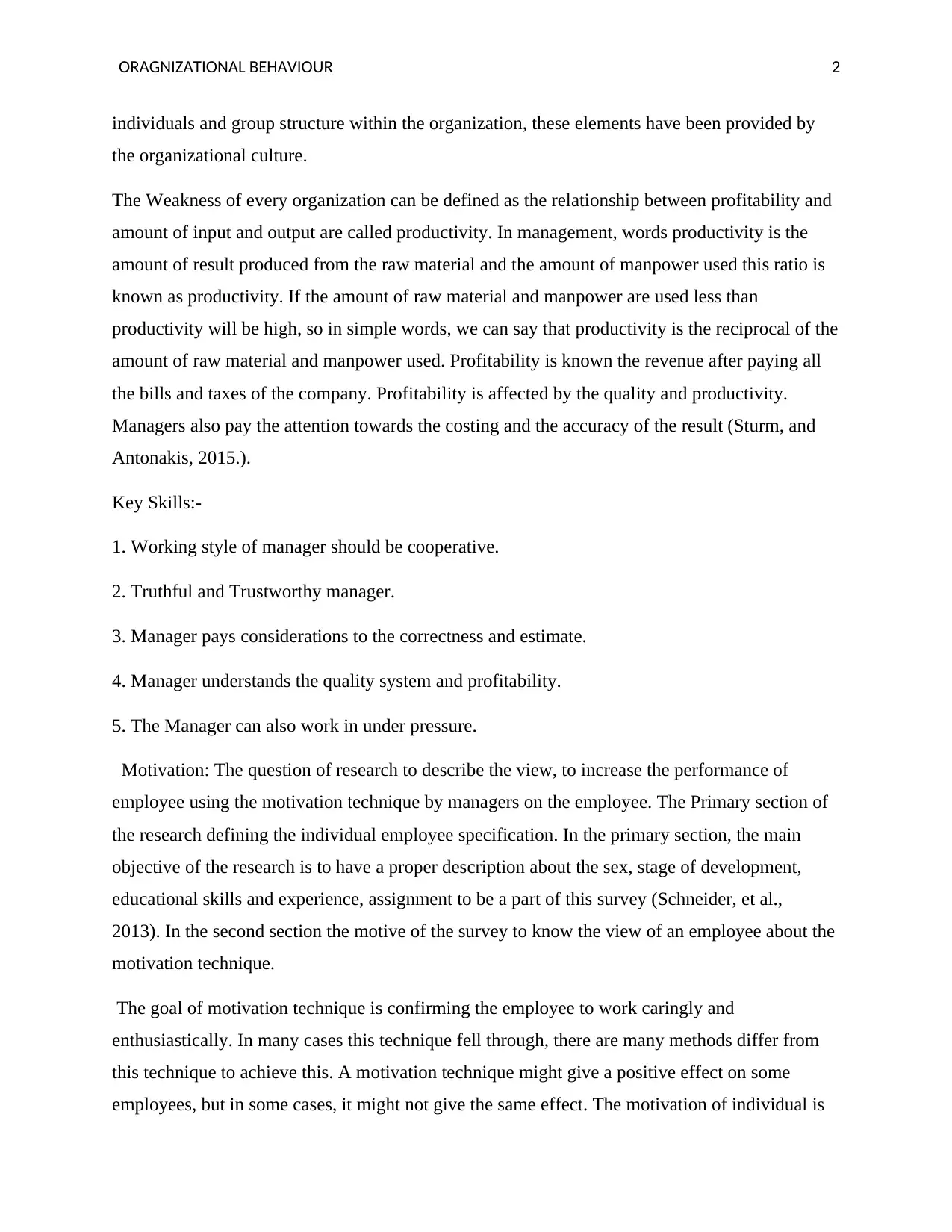
ORAGNIZATIONAL BEHAVIOUR 2
individuals and group structure within the organization, these elements have been provided by
the organizational culture.
The Weakness of every organization can be defined as the relationship between profitability and
amount of input and output are called productivity. In management, words productivity is the
amount of result produced from the raw material and the amount of manpower used this ratio is
known as productivity. If the amount of raw material and manpower are used less than
productivity will be high, so in simple words, we can say that productivity is the reciprocal of the
amount of raw material and manpower used. Profitability is known the revenue after paying all
the bills and taxes of the company. Profitability is affected by the quality and productivity.
Managers also pay the attention towards the costing and the accuracy of the result (Sturm, and
Antonakis, 2015.).
Key Skills:-
1. Working style of manager should be cooperative.
2. Truthful and Trustworthy manager.
3. Manager pays considerations to the correctness and estimate.
4. Manager understands the quality system and profitability.
5. The Manager can also work in under pressure.
Motivation: The question of research to describe the view, to increase the performance of
employee using the motivation technique by managers on the employee. The Primary section of
the research defining the individual employee specification. In the primary section, the main
objective of the research is to have a proper description about the sex, stage of development,
educational skills and experience, assignment to be a part of this survey (Schneider, et al.,
2013). In the second section the motive of the survey to know the view of an employee about the
motivation technique.
The goal of motivation technique is confirming the employee to work caringly and
enthusiastically. In many cases this technique fell through, there are many methods differ from
this technique to achieve this. A motivation technique might give a positive effect on some
employees, but in some cases, it might not give the same effect. The motivation of individual is
individuals and group structure within the organization, these elements have been provided by
the organizational culture.
The Weakness of every organization can be defined as the relationship between profitability and
amount of input and output are called productivity. In management, words productivity is the
amount of result produced from the raw material and the amount of manpower used this ratio is
known as productivity. If the amount of raw material and manpower are used less than
productivity will be high, so in simple words, we can say that productivity is the reciprocal of the
amount of raw material and manpower used. Profitability is known the revenue after paying all
the bills and taxes of the company. Profitability is affected by the quality and productivity.
Managers also pay the attention towards the costing and the accuracy of the result (Sturm, and
Antonakis, 2015.).
Key Skills:-
1. Working style of manager should be cooperative.
2. Truthful and Trustworthy manager.
3. Manager pays considerations to the correctness and estimate.
4. Manager understands the quality system and profitability.
5. The Manager can also work in under pressure.
Motivation: The question of research to describe the view, to increase the performance of
employee using the motivation technique by managers on the employee. The Primary section of
the research defining the individual employee specification. In the primary section, the main
objective of the research is to have a proper description about the sex, stage of development,
educational skills and experience, assignment to be a part of this survey (Schneider, et al.,
2013). In the second section the motive of the survey to know the view of an employee about the
motivation technique.
The goal of motivation technique is confirming the employee to work caringly and
enthusiastically. In many cases this technique fell through, there are many methods differ from
this technique to achieve this. A motivation technique might give a positive effect on some
employees, but in some cases, it might not give the same effect. The motivation of individual is
⊘ This is a preview!⊘
Do you want full access?
Subscribe today to unlock all pages.

Trusted by 1+ million students worldwide
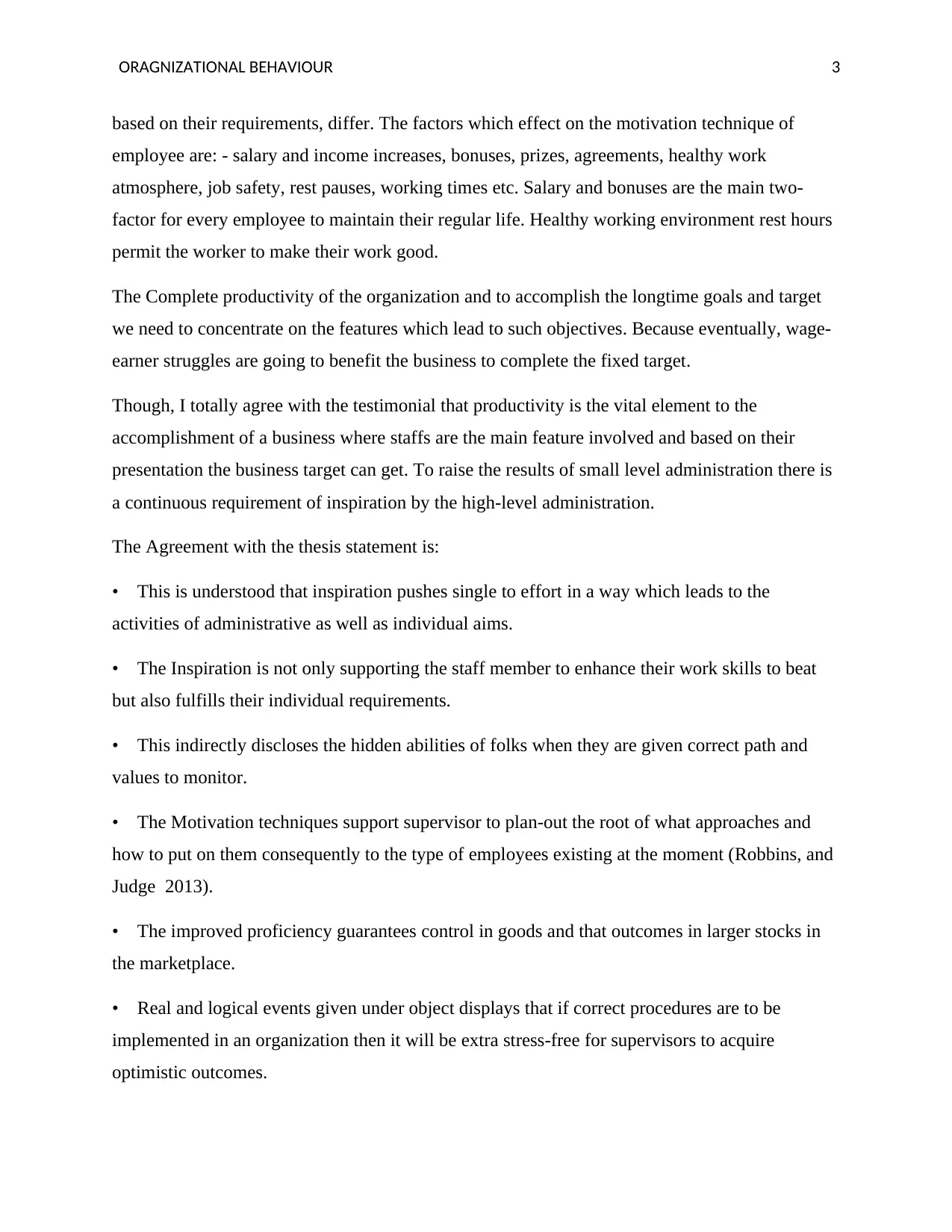
ORAGNIZATIONAL BEHAVIOUR 3
based on their requirements, differ. The factors which effect on the motivation technique of
employee are: - salary and income increases, bonuses, prizes, agreements, healthy work
atmosphere, job safety, rest pauses, working times etc. Salary and bonuses are the main two-
factor for every employee to maintain their regular life. Healthy working environment rest hours
permit the worker to make their work good.
The Complete productivity of the organization and to accomplish the longtime goals and target
we need to concentrate on the features which lead to such objectives. Because eventually, wage-
earner struggles are going to benefit the business to complete the fixed target.
Though, I totally agree with the testimonial that productivity is the vital element to the
accomplishment of a business where staffs are the main feature involved and based on their
presentation the business target can get. To raise the results of small level administration there is
a continuous requirement of inspiration by the high-level administration.
The Agreement with the thesis statement is:
• This is understood that inspiration pushes single to effort in a way which leads to the
activities of administrative as well as individual aims.
• The Inspiration is not only supporting the staff member to enhance their work skills to beat
but also fulfills their individual requirements.
• This indirectly discloses the hidden abilities of folks when they are given correct path and
values to monitor.
• The Motivation techniques support supervisor to plan-out the root of what approaches and
how to put on them consequently to the type of employees existing at the moment (Robbins, and
Judge 2013).
• The improved proficiency guarantees control in goods and that outcomes in larger stocks in
the marketplace.
• Real and logical events given under object displays that if correct procedures are to be
implemented in an organization then it will be extra stress-free for supervisors to acquire
optimistic outcomes.
based on their requirements, differ. The factors which effect on the motivation technique of
employee are: - salary and income increases, bonuses, prizes, agreements, healthy work
atmosphere, job safety, rest pauses, working times etc. Salary and bonuses are the main two-
factor for every employee to maintain their regular life. Healthy working environment rest hours
permit the worker to make their work good.
The Complete productivity of the organization and to accomplish the longtime goals and target
we need to concentrate on the features which lead to such objectives. Because eventually, wage-
earner struggles are going to benefit the business to complete the fixed target.
Though, I totally agree with the testimonial that productivity is the vital element to the
accomplishment of a business where staffs are the main feature involved and based on their
presentation the business target can get. To raise the results of small level administration there is
a continuous requirement of inspiration by the high-level administration.
The Agreement with the thesis statement is:
• This is understood that inspiration pushes single to effort in a way which leads to the
activities of administrative as well as individual aims.
• The Inspiration is not only supporting the staff member to enhance their work skills to beat
but also fulfills their individual requirements.
• This indirectly discloses the hidden abilities of folks when they are given correct path and
values to monitor.
• The Motivation techniques support supervisor to plan-out the root of what approaches and
how to put on them consequently to the type of employees existing at the moment (Robbins, and
Judge 2013).
• The improved proficiency guarantees control in goods and that outcomes in larger stocks in
the marketplace.
• Real and logical events given under object displays that if correct procedures are to be
implemented in an organization then it will be extra stress-free for supervisors to acquire
optimistic outcomes.
Paraphrase This Document
Need a fresh take? Get an instant paraphrase of this document with our AI Paraphraser
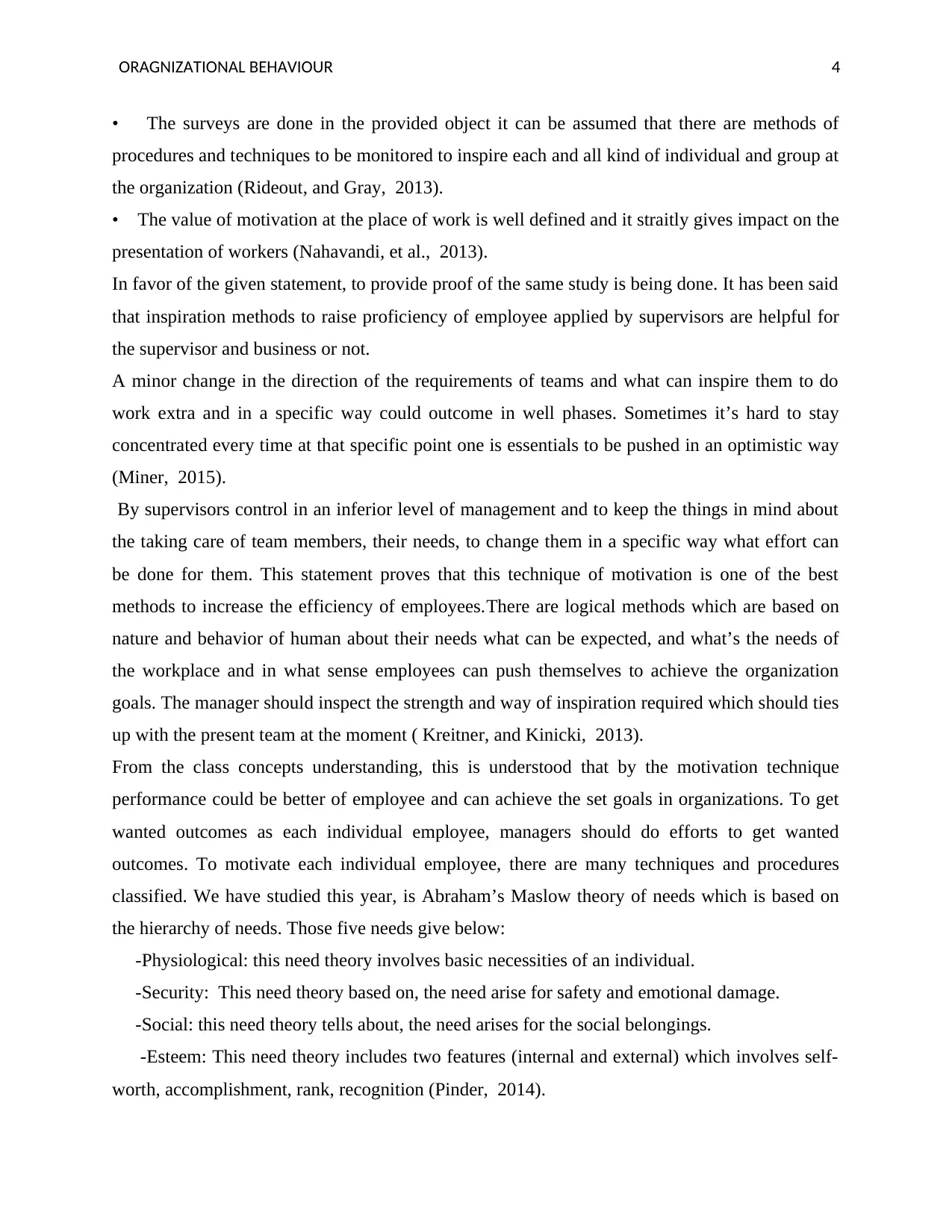
ORAGNIZATIONAL BEHAVIOUR 4
• The surveys are done in the provided object it can be assumed that there are methods of
procedures and techniques to be monitored to inspire each and all kind of individual and group at
the organization (Rideout, and Gray, 2013).
• The value of motivation at the place of work is well defined and it straitly gives impact on the
presentation of workers (Nahavandi, et al., 2013).
In favor of the given statement, to provide proof of the same study is being done. It has been said
that inspiration methods to raise proficiency of employee applied by supervisors are helpful for
the supervisor and business or not.
A minor change in the direction of the requirements of teams and what can inspire them to do
work extra and in a specific way could outcome in well phases. Sometimes it’s hard to stay
concentrated every time at that specific point one is essentials to be pushed in an optimistic way
(Miner, 2015).
By supervisors control in an inferior level of management and to keep the things in mind about
the taking care of team members, their needs, to change them in a specific way what effort can
be done for them. This statement proves that this technique of motivation is one of the best
methods to increase the efficiency of employees.There are logical methods which are based on
nature and behavior of human about their needs what can be expected, and what’s the needs of
the workplace and in what sense employees can push themselves to achieve the organization
goals. The manager should inspect the strength and way of inspiration required which should ties
up with the present team at the moment ( Kreitner, and Kinicki, 2013).
From the class concepts understanding, this is understood that by the motivation technique
performance could be better of employee and can achieve the set goals in organizations. To get
wanted outcomes as each individual employee, managers should do efforts to get wanted
outcomes. To motivate each individual employee, there are many techniques and procedures
classified. We have studied this year, is Abraham’s Maslow theory of needs which is based on
the hierarchy of needs. Those five needs give below:
-Physiological: this need theory involves basic necessities of an individual.
-Security: This need theory based on, the need arise for safety and emotional damage.
-Social: this need theory tells about, the need arises for the social belongings.
-Esteem: This need theory includes two features (internal and external) which involves self-
worth, accomplishment, rank, recognition (Pinder, 2014).
• The surveys are done in the provided object it can be assumed that there are methods of
procedures and techniques to be monitored to inspire each and all kind of individual and group at
the organization (Rideout, and Gray, 2013).
• The value of motivation at the place of work is well defined and it straitly gives impact on the
presentation of workers (Nahavandi, et al., 2013).
In favor of the given statement, to provide proof of the same study is being done. It has been said
that inspiration methods to raise proficiency of employee applied by supervisors are helpful for
the supervisor and business or not.
A minor change in the direction of the requirements of teams and what can inspire them to do
work extra and in a specific way could outcome in well phases. Sometimes it’s hard to stay
concentrated every time at that specific point one is essentials to be pushed in an optimistic way
(Miner, 2015).
By supervisors control in an inferior level of management and to keep the things in mind about
the taking care of team members, their needs, to change them in a specific way what effort can
be done for them. This statement proves that this technique of motivation is one of the best
methods to increase the efficiency of employees.There are logical methods which are based on
nature and behavior of human about their needs what can be expected, and what’s the needs of
the workplace and in what sense employees can push themselves to achieve the organization
goals. The manager should inspect the strength and way of inspiration required which should ties
up with the present team at the moment ( Kreitner, and Kinicki, 2013).
From the class concepts understanding, this is understood that by the motivation technique
performance could be better of employee and can achieve the set goals in organizations. To get
wanted outcomes as each individual employee, managers should do efforts to get wanted
outcomes. To motivate each individual employee, there are many techniques and procedures
classified. We have studied this year, is Abraham’s Maslow theory of needs which is based on
the hierarchy of needs. Those five needs give below:
-Physiological: this need theory involves basic necessities of an individual.
-Security: This need theory based on, the need arise for safety and emotional damage.
-Social: this need theory tells about, the need arises for the social belongings.
-Esteem: This need theory includes two features (internal and external) which involves self-
worth, accomplishment, rank, recognition (Pinder, 2014).
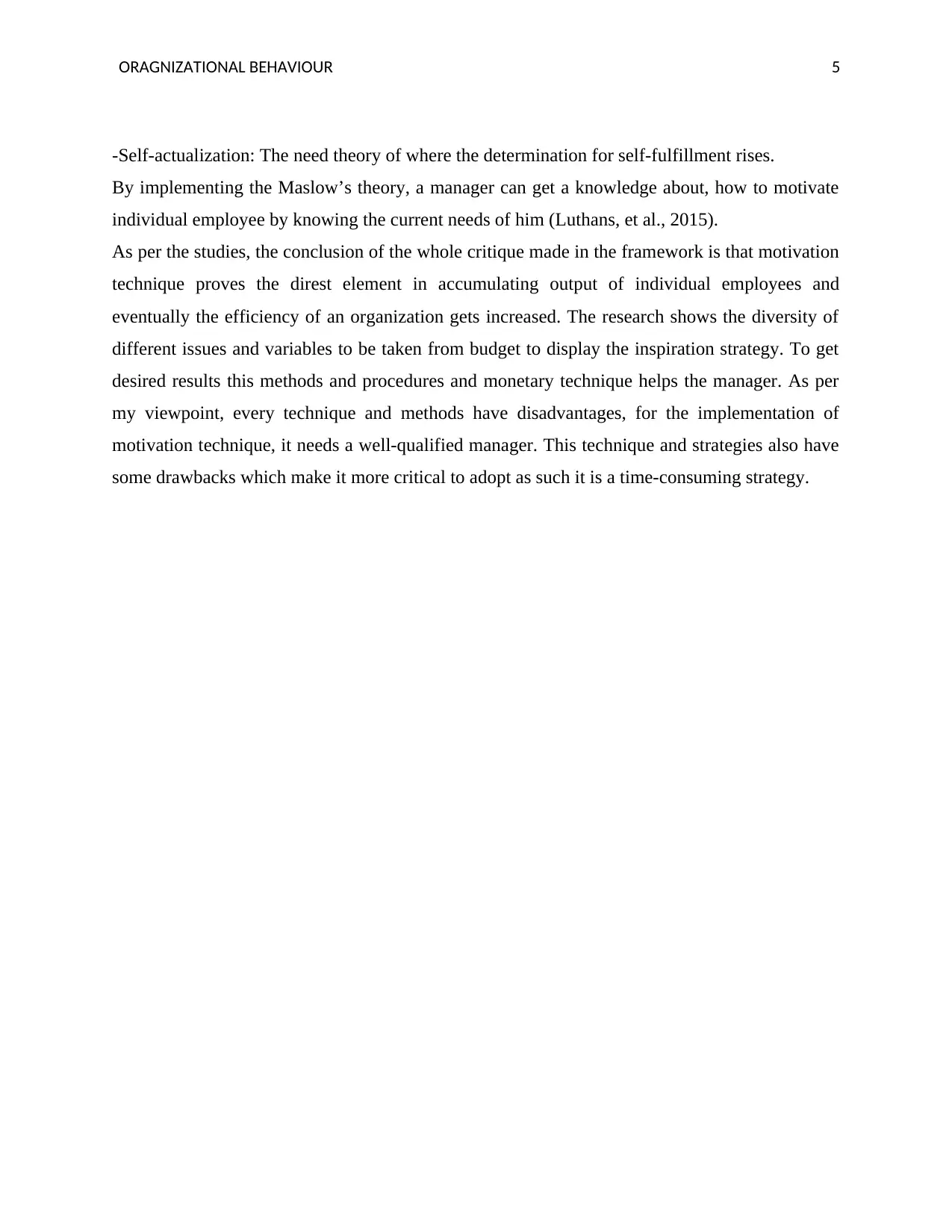
ORAGNIZATIONAL BEHAVIOUR 5
-Self-actualization: The need theory of where the determination for self-fulfillment rises.
By implementing the Maslow’s theory, a manager can get a knowledge about, how to motivate
individual employee by knowing the current needs of him (Luthans, et al., 2015).
As per the studies, the conclusion of the whole critique made in the framework is that motivation
technique proves the direst element in accumulating output of individual employees and
eventually the efficiency of an organization gets increased. The research shows the diversity of
different issues and variables to be taken from budget to display the inspiration strategy. To get
desired results this methods and procedures and monetary technique helps the manager. As per
my viewpoint, every technique and methods have disadvantages, for the implementation of
motivation technique, it needs a well-qualified manager. This technique and strategies also have
some drawbacks which make it more critical to adopt as such it is a time-consuming strategy.
-Self-actualization: The need theory of where the determination for self-fulfillment rises.
By implementing the Maslow’s theory, a manager can get a knowledge about, how to motivate
individual employee by knowing the current needs of him (Luthans, et al., 2015).
As per the studies, the conclusion of the whole critique made in the framework is that motivation
technique proves the direst element in accumulating output of individual employees and
eventually the efficiency of an organization gets increased. The research shows the diversity of
different issues and variables to be taken from budget to display the inspiration strategy. To get
desired results this methods and procedures and monetary technique helps the manager. As per
my viewpoint, every technique and methods have disadvantages, for the implementation of
motivation technique, it needs a well-qualified manager. This technique and strategies also have
some drawbacks which make it more critical to adopt as such it is a time-consuming strategy.
⊘ This is a preview!⊘
Do you want full access?
Subscribe today to unlock all pages.

Trusted by 1+ million students worldwide
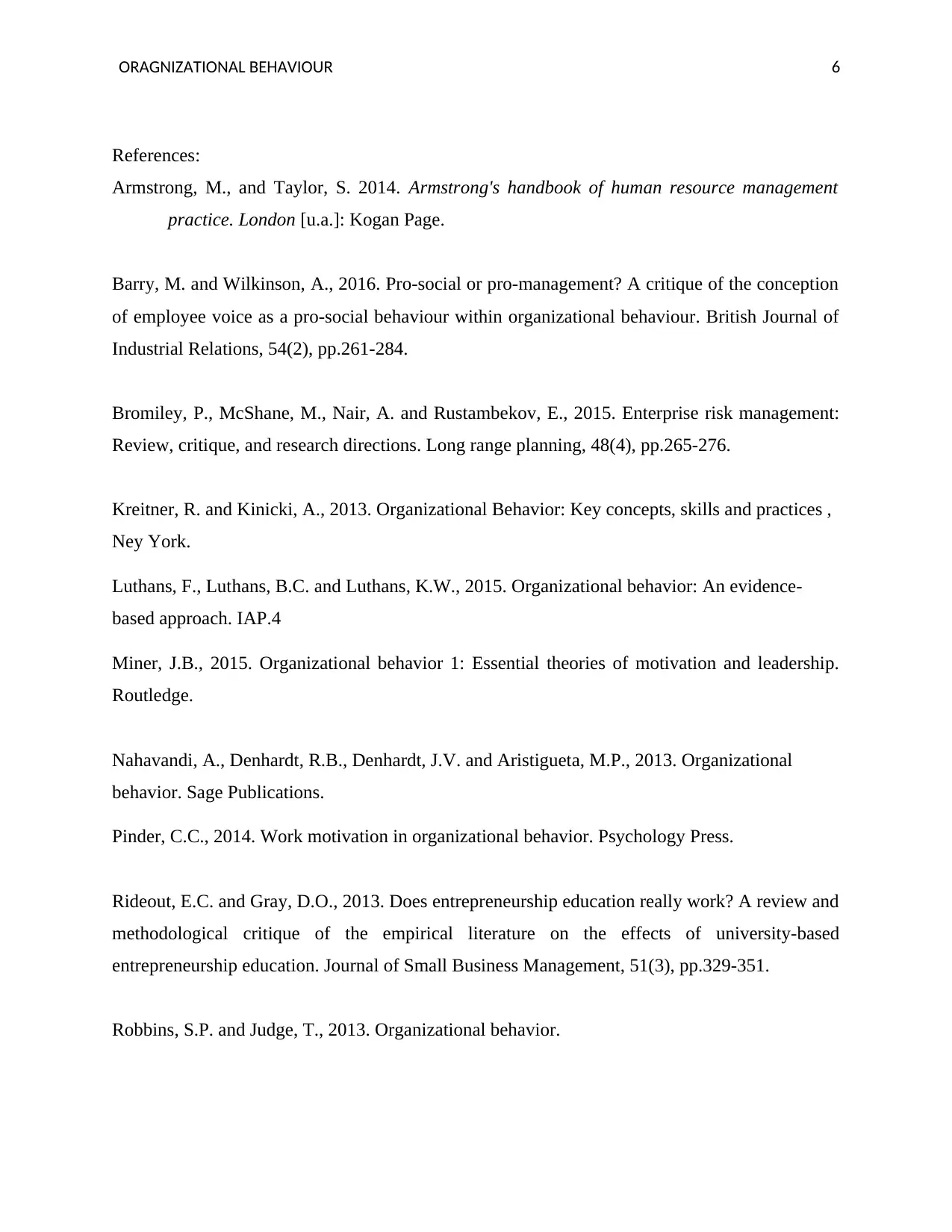
ORAGNIZATIONAL BEHAVIOUR 6
References:
Armstrong, M., and Taylor, S. 2014. Armstrong's handbook of human resource management
practice. London [u.a.]: Kogan Page.
Barry, M. and Wilkinson, A., 2016. Pro‐social or pro‐management? A critique of the conception
of employee voice as a pro‐social behaviour within organizational behaviour. British Journal of
Industrial Relations, 54(2), pp.261-284.
Bromiley, P., McShane, M., Nair, A. and Rustambekov, E., 2015. Enterprise risk management:
Review, critique, and research directions. Long range planning, 48(4), pp.265-276.
Kreitner, R. and Kinicki, A., 2013. Organizational Behavior: Key concepts, skills and practices ,
Ney York.
Luthans, F., Luthans, B.C. and Luthans, K.W., 2015. Organizational behavior: An evidence-
based approach. IAP.4
Miner, J.B., 2015. Organizational behavior 1: Essential theories of motivation and leadership.
Routledge.
Nahavandi, A., Denhardt, R.B., Denhardt, J.V. and Aristigueta, M.P., 2013. Organizational
behavior. Sage Publications.
Pinder, C.C., 2014. Work motivation in organizational behavior. Psychology Press.
Rideout, E.C. and Gray, D.O., 2013. Does entrepreneurship education really work? A review and
methodological critique of the empirical literature on the effects of university‐based
entrepreneurship education. Journal of Small Business Management, 51(3), pp.329-351.
Robbins, S.P. and Judge, T., 2013. Organizational behavior.
References:
Armstrong, M., and Taylor, S. 2014. Armstrong's handbook of human resource management
practice. London [u.a.]: Kogan Page.
Barry, M. and Wilkinson, A., 2016. Pro‐social or pro‐management? A critique of the conception
of employee voice as a pro‐social behaviour within organizational behaviour. British Journal of
Industrial Relations, 54(2), pp.261-284.
Bromiley, P., McShane, M., Nair, A. and Rustambekov, E., 2015. Enterprise risk management:
Review, critique, and research directions. Long range planning, 48(4), pp.265-276.
Kreitner, R. and Kinicki, A., 2013. Organizational Behavior: Key concepts, skills and practices ,
Ney York.
Luthans, F., Luthans, B.C. and Luthans, K.W., 2015. Organizational behavior: An evidence-
based approach. IAP.4
Miner, J.B., 2015. Organizational behavior 1: Essential theories of motivation and leadership.
Routledge.
Nahavandi, A., Denhardt, R.B., Denhardt, J.V. and Aristigueta, M.P., 2013. Organizational
behavior. Sage Publications.
Pinder, C.C., 2014. Work motivation in organizational behavior. Psychology Press.
Rideout, E.C. and Gray, D.O., 2013. Does entrepreneurship education really work? A review and
methodological critique of the empirical literature on the effects of university‐based
entrepreneurship education. Journal of Small Business Management, 51(3), pp.329-351.
Robbins, S.P. and Judge, T., 2013. Organizational behavior.
Paraphrase This Document
Need a fresh take? Get an instant paraphrase of this document with our AI Paraphraser
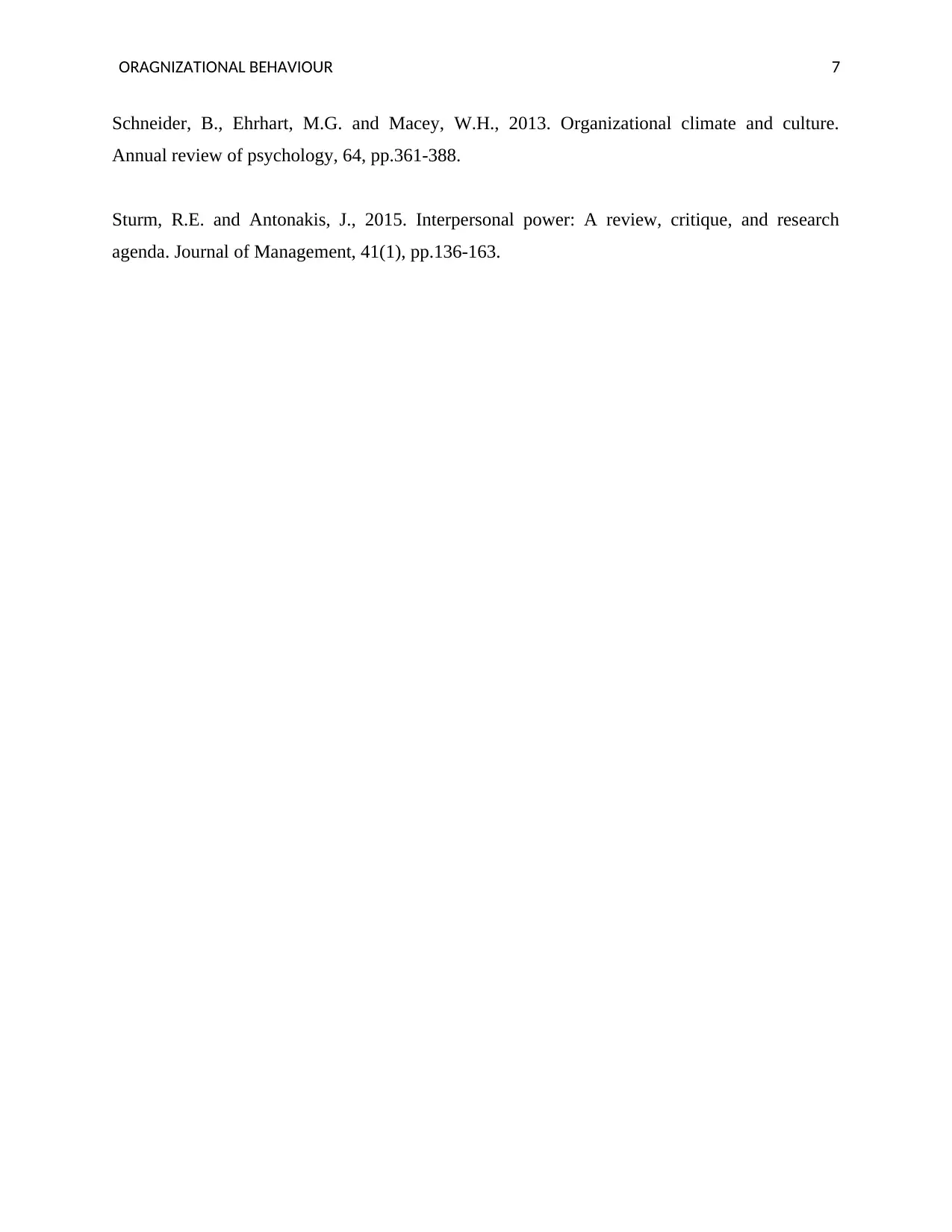
ORAGNIZATIONAL BEHAVIOUR 7
Schneider, B., Ehrhart, M.G. and Macey, W.H., 2013. Organizational climate and culture.
Annual review of psychology, 64, pp.361-388.
Sturm, R.E. and Antonakis, J., 2015. Interpersonal power: A review, critique, and research
agenda. Journal of Management, 41(1), pp.136-163.
Schneider, B., Ehrhart, M.G. and Macey, W.H., 2013. Organizational climate and culture.
Annual review of psychology, 64, pp.361-388.
Sturm, R.E. and Antonakis, J., 2015. Interpersonal power: A review, critique, and research
agenda. Journal of Management, 41(1), pp.136-163.
1 out of 8
Related Documents
Your All-in-One AI-Powered Toolkit for Academic Success.
+13062052269
info@desklib.com
Available 24*7 on WhatsApp / Email
![[object Object]](/_next/static/media/star-bottom.7253800d.svg)
Unlock your academic potential
Copyright © 2020–2025 A2Z Services. All Rights Reserved. Developed and managed by ZUCOL.





